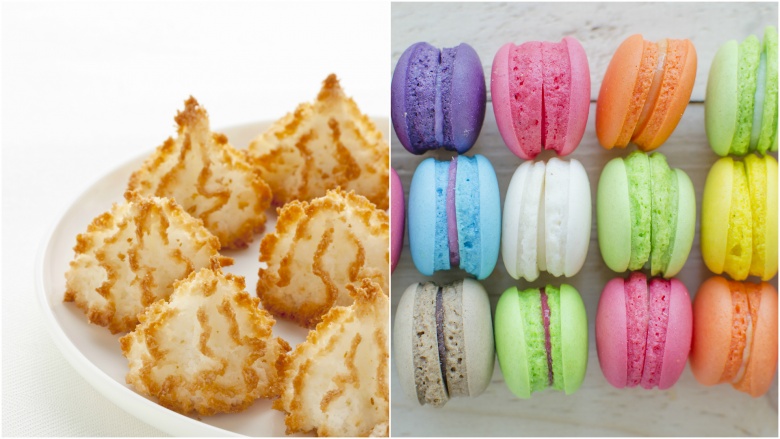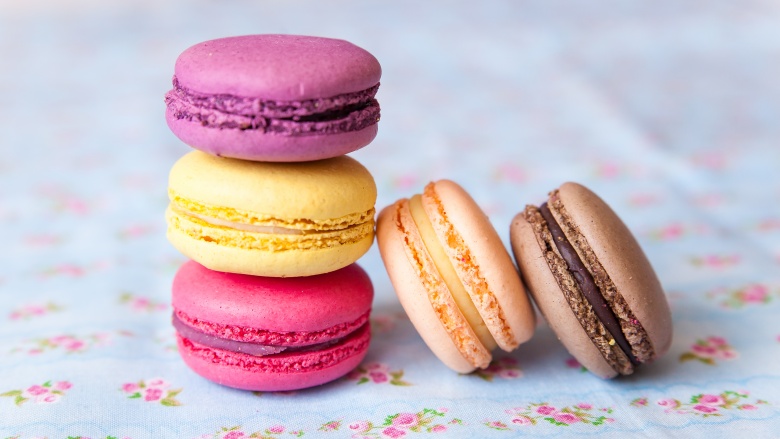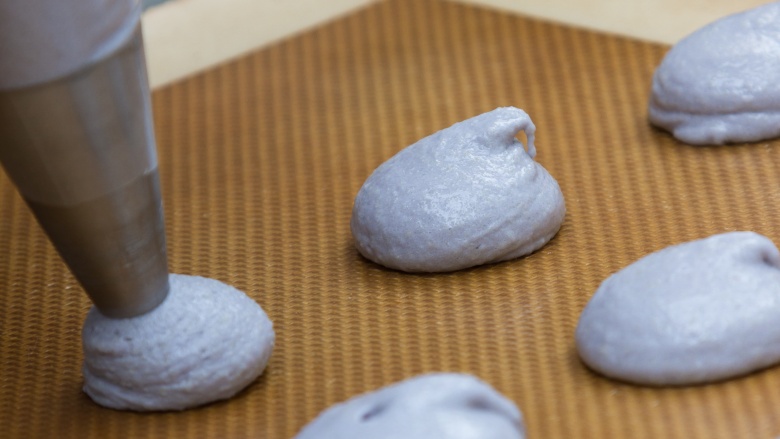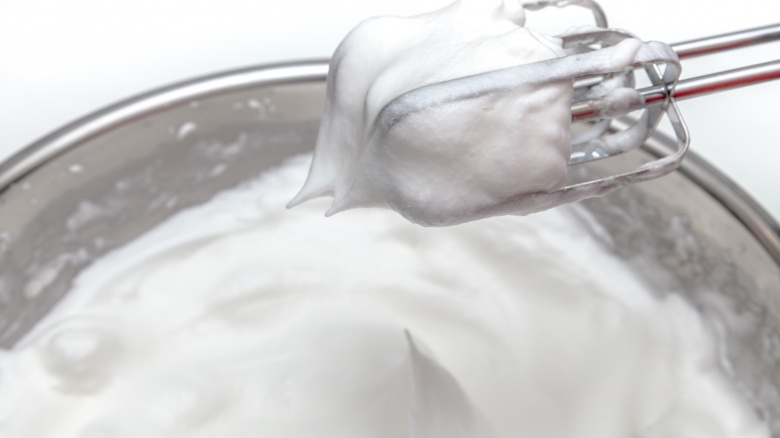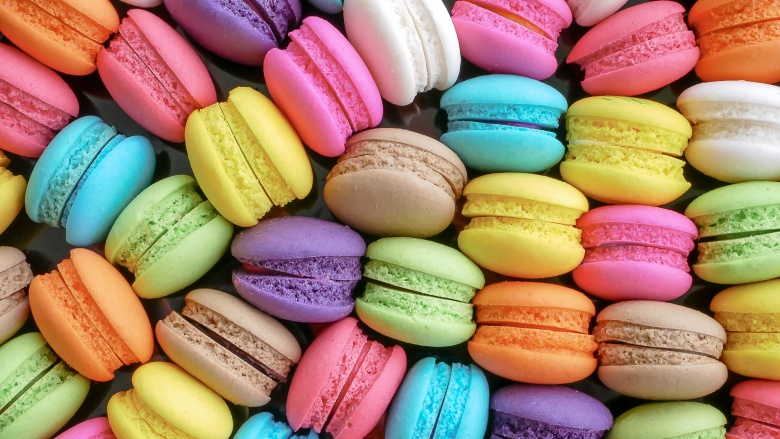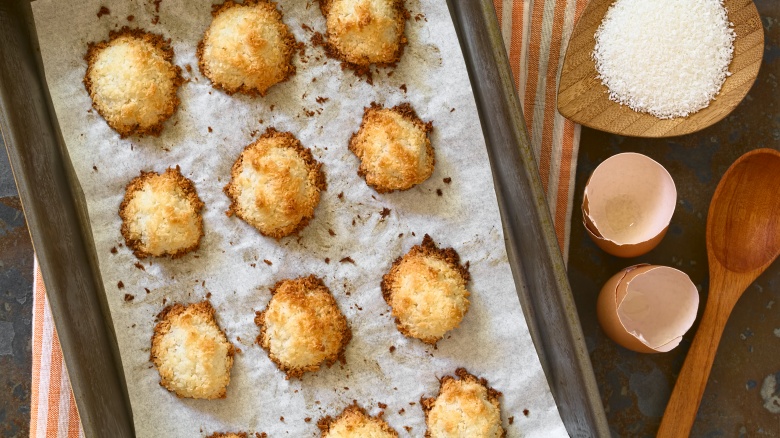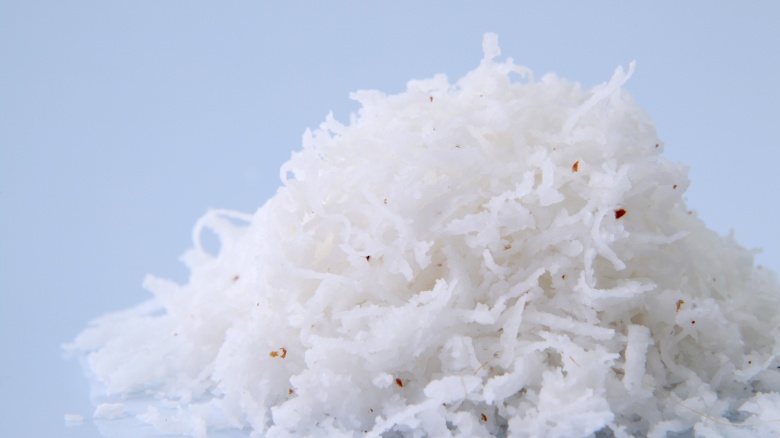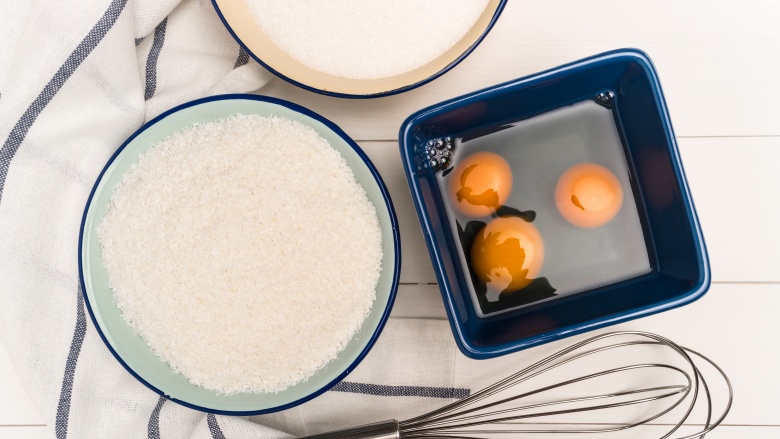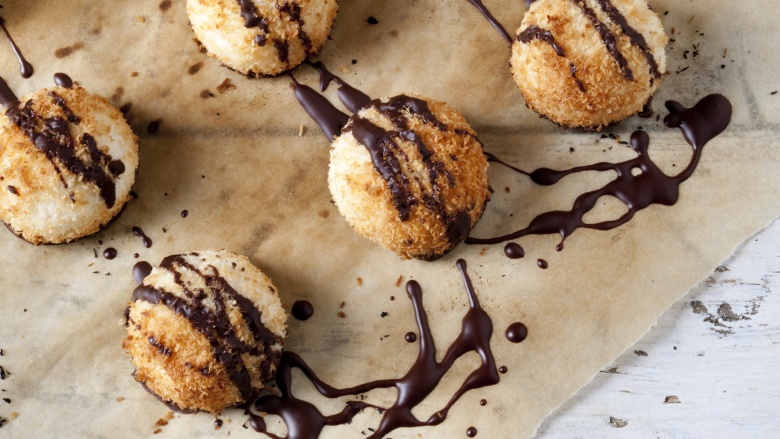The Difference Between Macarons And Macaroons
It's easy to mix up macaroons with macarons. There's a good chance you thought it was just a different way to pronounce the name of the same treat, right? For one thing, there's only one letter difference between the names of these two popular cookies. What's more, both cookies are made with the same basic ingredients, with one exception — one features ground almonds and the other is made with shredded coconut. Dig in below and learn a little more about these cookie's beginnings and explore how each is made. There are a lot more differences than you might think.
They don't look the same
The easiest way to tell macarons and macaroons apart is by their appearance. One is a round sandwich cookie and the other is a mounded cookie that's either dropped, piped or shaped. Macarons are sandwich cookies that come in a rainbow of colors. The eggshell-like surfaces of these cookies are smooth with a satiny sheen. Macaroons, on the other hand, have a fluffy appearance due to their main ingredient, shredded coconut. Macaroons are white with lightly golden toasted edges. How ragged the surface is will depend on whether the macaroon cookies are piped or slightly shaped to resemble balls or small mounds, or if they are simply dropped from spoons and left alone.
History of the macaron
Macarons (pronounced mah-ca-ron) are delicate sandwich cookies made with ground almonds, egg whites and sugar. The airy cookie has a crisp exterior and a chewy interior. The filling can be creamy or fruity, depending on the cookie flavor and style. While macarons are usually considered a French treat, details about the cookie's origins are a little hazy. Most historians agree though that the cookie likely dates back to eighth century Venice, around the same time almonds were introduced to the region by the Arabs and early versions of the treat were made at some of the area monasteries. In fact, the word "macaron" is a derivative of the Italian word "macaroni."
The treats made their way to France (possibly brought there in 1533 by Catherine de Medici, when she married King Henry II) and grew in popularity over time. Along the way, many French cities such as Nancy become known for their particular macaron styles, but it wasn't until the early 1900s the smooth, round macaron with its iconic rough bottom edge (called the foot) came to be. It happened at a well established Parisian patisserie, La Maison Ladurée, and once their version of the French macaron was introduced — in a rainbow of colors and flavors — it became a symbol of elegance and high-end cuisine.
How to make French macarons
They may look like they require the skill of a highly-trained pastry chef, but you can make French macarons at home using ingredients easily found at the supermarket — and you don't need a lot of specialty cooking equipment either. For this French macaron recipe (and most others), the main ingredients include almond flour, confectioners' sugar, granulated sugar and egg whites. To make macarons, you'll first grind the almond flour and confectioners' sugar together in the food processor until it becomes a very fine powder. The egg whites and sugar are beaten together next to a stiff meringue. Next, the almond mixture gets gently folded into the meringue to complete the batter. Flavor and any desired coloring are added at this point too — but no more than is needed to make sure the addition doesn't deflate the airy egg white base. The batter gets piped into little rounds on the baking sheet and is baked for about 15 minutes. The finished cookie shells sit to cool and then become the sandwich for buttercream, ganache or jelly filling.
Tips for making French macarons
The trick to making great French macarons is to take care with each step. Grind the almond flour well so the macaron tops are smooth and sift sugar first if the recipe directs you to. When beating the meringue, make sure the bowl and beaters are free of any oils or residue, otherwise they might not reach their full volume. For the most uniform cookies, place a template under the parchment paper or draw circles onto the paper to use as a guide while piping. Make sure to flip the parchment over so the side you drew on is face-down and won't come in contact with the batter. Watch that you don't under-bake the macarons — they'll be difficult to remove from the parchment if you do and also might deflate once they are out of the oven.
If you want even more tips, Brave Tart has some more sensible advice that won't have you pulling out your hair when you make these cookies.
Flavors and fillings for French macarons
There's no such thing as a boring macaron, but you can make yours even more exciting by trying flavors you don't find every day like blueberry cheesecake. Cereal even gets into the act with these Fruity Pebbles macarons. You can also just go with classics like pistachio, strawberry, mango and chocolate French macarons. And if you don't feel like making your own, there's an option to have them delivered right to you doorstep.
Desert may be what you envision when you think of macarons, but they are also served in savory flavors too. As an appetizer, they might get filled with a salmon cream, caviar, a creamy vegetable spread and even ketchup!
History of the macaroon
Macaroons (pronounced mack-ha- roon) are made with egg whites, sugar and dried shredded coconut. These gluten-free and unleavened cookies (let's call them coconut macaroons going forward) are especially popular during Passover and are related to their French macaron cousins. Coconut macaroons got their start in America, replacing almonds in French macarons when a new technology for drying and shredding coconut meat was introduced in the late 1800s. This sweet coconut cookie has a soft, moist interior and a golden toasted exterior.
How to make coconut macaroons
To make coconut macaroons you also only need a few pantry ingredients, plus shredded coconut. Some recipes may call for desiccated coconut which is available at specialty foods stores and some supermarkets, but many call for sweetened shredded coconut which is easy to find in the grocery baking aisle. The egg whites are whipped for these cookies and then folded into a mixture of sweetened condensed milk, shredded coconut, and vanilla to form a dough. Sometimes a recipe won't call for sweetened condensed milk and will use sugar instead, or it might not require the egg whites to be beaten to peaks in a separate bowl. These differences will affect the texture and creaminess of the macaroon, and are just a matter of personal taste. Coconut macaroons made without having to whip the egg make the cookie a one-bowl affair and super easy to perfect. Coconut macaroons are especially easy to form and bake — depending on the recipe, you can either drop spoonfuls of the dough onto a baking sheet or roll or shape them into small mounds and place them onto the pan. Lightly toasting the coconut before using it in the dough will release some of its oils and amp up coconut flavor.
Tips for making coconut macaroons
Coconut macaroons are pretty easy to make, but to avoid any glitches follow these guidelines:
1. Make sure to use the correct type of coconut. If the recipe calls for desiccated coconut, make sure to buy the unsweetened variety. Desiccated coconut is shredded and dried without the addition of sugar. Sweetened coconut is combined with sugar and only partially dried. Read your recipe carefully to prevent making a batch of under- or over-sweetened cookies — or cookies that are too wet or overly dry.
2. Don't skip the parchment paper and don't substitute waxed paper for parchment — these sugary cookies will adhere to the waxed paper, and they'll also be very difficult to pry off of an uncovered pan. Coconut macaroons will lift easily from parchment. If you have a silicone baking liner, you can use it in place of parchment without a problem of sticking.
3. Lightly dampen your hands if you plan to shape the cookies to make working with dough a neater process.
Variations for coconut macaroons
It's easy to dress up plain coconut macaroons with simple embellishments. Drizzle cooled macaroons with caramel or your favorite kind of melted chocolate. Brighten the rich coconut flavor with a hint of fruit by stirring chopped apricots, dried cranberries, chopped candied cherries, or candied lemon or orange peel into the dough. You can even add fresh berries to coconut macaroons. For a copycat of an Almond Joy candy bar, press an almond into the cookie and dip in chocolate.

